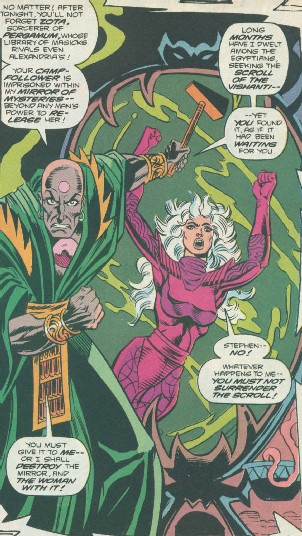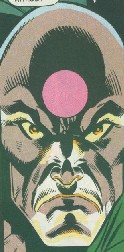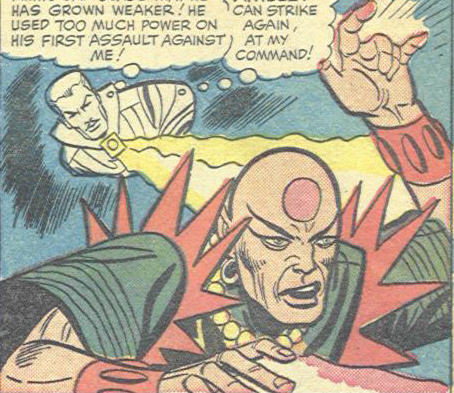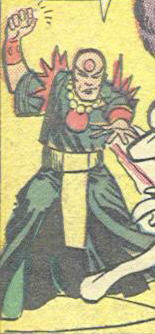
ZOTA OF PERGAMUM

Real Name: Zota
Identity/Class: Magic user, circa 47-37 B.C.
Occupation: Would-be conqueror
Group Membership: None
Affiliations: King Ptolemy
Enemies: Gaius Julius Caesar, Cleopatra, Dr. Strange, Clea, Marc Antony
Known Relatives: None
Aliases: None
Base of Operations: Egypt, circa 47-37 B.C.
First Appearance: Strange Tales I#124 (September, 1964)
Powers: Zota possessed remarkable magical abilities and paraphenalia, including power over time-travel, an enchanted green mirror that could be used to entrap people, and the Prison of Rolling Light, two mirror-like objects that could entrap even an astral form. However, the Rolling Light otherwise largely functioned as normal light would, and could be stopped by thick smoke. Zota claimed to have a vast library of magical documents as well.
Height: 5' 8"
Weight: 143 lbs.
Eyes: Brown
Hair: Bald

History: Little has come to light about Zota’s early history. He may not have come from Egypt, but only went there in search of the Scroll of the Vishanti, which he thought might have become part of the collection of the vast Library of Alexandria. In any event, he supported King Ptolemy of Egypt against Julius Caesar and Cleopatra.
(Doctor Strange: Sorcerer Supreme#33)- During the "Infinity Gauntlet", Thanos banished Doctor Strange and Clea into the timestream. Strange and Clea pooled their efforts to return to Earth, but wound up coming to the era of circa 47 B.C. Strange recognized the Lighthouse of Pharos in Alexandria, Egypt. Realizing that in this time period the great Library of Alexandria still existed, and further that such a vast library might contain scrolls detailing mystical spells, Strange and Clea set out to find it. However, they received a rude surprise when they saw a fire near the city’s docks, as Strange realized that they had arrived during a civil war between the Egyptians who supported the Romans and the Egyptians who supported the Greek Macedonians. Strange had read of an account that stated that the Library of Alexandria had been destroyed during Caesar’s siege of Alexandria, and was only replenished years later by Marc Anthony. However, Strange, since they had been drawn to the location of Alexandria, presumed that some sort of magic scroll or talisman must still exist somewhere in the city, and so sought to find the royal palace. Clea and Strange flew away, thinking themselves unobserved. However, Zota of Pergamum saw them.
Arriving at the palace, Strange and Clea met Julius Caesar and Cleopatra. Caesar described his intention to place Cleopatra on Egypt’s throne, favoring her over her brother. Cleopatra did not recognize Doctor Strange, leading him to realize that he had previously encountered her counterpart from circa 37 B.C. (see below). Strange and Clea, after discovering that only a warehouse, not the Library of Alexandria, had been burned in the fire they saw from talking to Cleopatra, set off to find the Library.

(Strange remembered that, despite the popular legend that Caesar had burned the Library of Alexandria, no historical evidence had been discovered to verify this story, and in fact a Roman named Lucan only wrote that a warehouse containing "grain and books" stored for export was burned down in a defensive fire set by Caesar’s fighters.)
At the Library, Strange did find a scroll of what would later become the Book of Vishanti. However, Zota also arrived at the Library and imprisoned Clea in a magical mirror. Strange recognized Zota, but Zota did not recognize Strange, for the same reason Cleopatra did not. Zota revealed how he had long searched for the Scroll of Vishanti, and demanded it from Strange, whom he mistook for a Roman.
Strange refused to give Zota the scroll, and so Zota began to lightly hit the mirror that imprisoned Clea. However, changing his mind apparently, Strange threw the scroll to Zota. The scroll blasted Zota when he tried to touch it. Strange had reasoned that Zota could not find the Scroll earlier because the Scroll probably had an enchantment to prevent its use by the unworthy, and had hid itself from Zota. When Zota tried to touch the Scroll, the enchantment worked to shock him to prevent his use of it.

Strange and Clea returned to their native time period, with the aid of Dr. Druid.
BTS- Circa 37 B.C. Zota managed briefly to unseat Marc Antony, but Cleopatra spurned Zota’s advances. Zota punished her by sending her to the future in a dazed state of mind. Dr. Strange (of the time chronologically before Zota's prior encounter with him, when Strange was still a young mystic) found her in modern New York and followed the mystical energy around her to her native time period.
(Strange Tales I#124)- The circa 37 B.C. Zota received a warning signal from his impulse transmitter. When Doctor Strang arrived in Zota’s time in astral form, Zota incapacitated him in his Prison of Rolling Light. However, seeing a nearby brazier, Strange used his amulet to direct the smoke in front of the generators of the Rolling Light, obstructing it and freeing himself. Zota lashed out with "negative energy" from the Netherworld, but Strange hid in the smoke. Zota overexerted himself with his first attack, so Strange managed to gain control of his will. Probing Zota’s mind, Strange also removed his mystical powers. Strange later returned to his native time period, and returned Cleopatra to 37 B.C.
Comments: Created by Stan Lee and Steve Ditko.
All right, admittedly this entry may read a bit confusingly, as Zota's two appearances take place in reverse chronological order for him, but forward for Dr. Strange.
Zota’s flesh tone changed from his first published appearance to his second. In his first appearance, he was colored as fair-skinned, while his second appearance colored him as more swarthy. This reminds me of how DC used to color the ancient Egyptian villain Black Adam as fair-skinned, until somebody realized that an ancient Egyptian would not resemble a typical America in complexion, and so started coloring Black Adam as darker in the Shazam:the New Beginning mini-series, Suicide Squad, and War of the Gods. It feels refreshing to seen an attempt to weed out such anachronisms. However, to deal with a common misconception, I will mention that, despite the claims of some Afrocentric nationalists, Cleopatra was not black, as her family was not even native to Egypt. Rather, one of her ancestors served as one of Alexander the Great’s generals, who inherited a part of Alexander the Great’s vast empire-- which included Egypt. The name Cleopatra is actually Greek, not Egyptian. (Note: Alexander the Great actually somehow time-travelled back to the Hyborian Era, in Conan the Barbarian I#79-80.) http://www.straightdope.com/mailbag/mcleopatra.html
As regards the Library of Alexandria, it came about because Cleopatra’s family, the Ptolemies, collected more than 500,000 volumes, possibly 700,000, for the use of scholars. The Library no doubt underwent wear and tear over the years, as Egypt was passed around from Greeks to Romans to Arabs, but as to what served to finally destroy, it there exists controversy. To quote from Joseph McCabe’s The Rationalist Encyclopedia (1950 edition, page 14) notes that Alexandria served as a great center of learning and science under the Greek Ptolemy dynasty, a gatherng ground of historians and other scholars, and "It was mainly from the works of these Alexandrians that the Arabs and Persians restored science four centuries later, but the complete destruction of the great academy by the monks and people of Alexandria under Archbishop Theophilus in A.D. 389 (Gibbon, Ch. XXVIII), after six centuries of magnificent service, has left only fragments of their work". McCabe states that "Some religious writers deny that the Christians under Theophilus destroyed this library, and quote the Arab writer Abulpharaj saying that when the Arabs invaded Egypt they found it still so large that they fed the public baths (4,000 in number !) for six months with the books. They omit to state that no contemporary Arab or Christian writer mentions this Arab vandalism, and that Abulpharaj, in whose work the story first appears, lived 600 years later; while we learn of the earlier Christian vandalism from Christian historians of the time. Professor Bury, whose notes to Gibbon (appendix to Vol. III) are here strangely inconsistent, admits these facts, yet rather arbitarily thinks that a large number of books may have survived to Arab times". (Gibbon here refers to Edward Gibbon, author of The Rise and Fall of the Roman Empire. As to the Arabs and Persians restoring science, in contrast to the current status quo, the Arabs had actually reached a much higher standard of civilization than Europe in the middle ages, and their influence helped produce the Renaissance.)
Additional information Additional information Additional information
Zota has an entry in Marvel Legacy: The 1960s Handbook.
by Per Degaton
Clarifications: Zota should not be confused with:
Appearances:
Strange Tales I#124 (September, 1964) - Stan Lee (writer/editor), Steve Ditko (penciler), George Roussos (inker)
Doctor Strange: Sorcerer Supreme#33 (September, 1991) - Roy & Dann Thomas (writers), Chris Marrinan (pencils), Mark McKenna & friends (inks), Mike Rockwitz (editor)
First Posted: 07/20/2002
Last updated: 02/26/2004
Any Additions/Corrections? please let me know.
Non-Marvel Copyright info
All other characters mentioned or pictured are ™ and © 1941-2099 Marvel
Characters, Inc. All Rights Reserved. If you like this stuff, you should check
out the real thing!
Please visit The Marvel Official Site at:
http://www.marvel.com
Special Thanks to www.g-mart.com for hosting the Appendix, Master List, etc.!